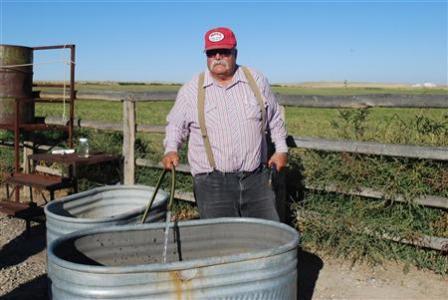Fracking Splits Wyoming Town At Center Of Debate
Date: 21-Dec-11
Country: U.S.
Author: Laura Zuckerman

Louis Meeks, a farmer near Pavillion, Wyoming, fills a trough with
contaminated water from his well on September 17, 2009.
Photo: Jon Hurdle
Before the energy companies came to town, talk at Pavillion's sole watering hole centered on the introduction of $3 Guinness beer on tap.
But when a U.S. natural gas boom hit this village of 150 people, the focus of discussion at Possum Pete's bar and across the once tight-knit community shifted.
As the gas well count swells to outnumber the residents, Pavillion, in west-central Wyoming, has found itself at the epicenter of a national debate over the potential threat that drilling fluids pose to drinking water.
The Environmental Protection Agency on December 8 offered evidence that chemicals applied in the hydraulic fracturing, or fracking, process that has led to a record surge in U.S. gas production this year, have likely tainted Pavillion's aquifer.
The findings have divided the community precious about its -water but in need of the money and jobs that drilling can bring. Residents in Pavillion as in hundreds of towns across the United States, are finding little middle ground on the controversial process.
"You're for it or you're against it," said Cyndy O'Neal, bartender at Possum Pete's.
Encana Corp ECA.TO , the company drilling in the area, rejected the report's findings. It denies any link between fracking and contaminated water, though it has been trucking water to several families in the town for over a year after federal health officials advised them to stop drinking water from their wells.
"We need clean water; we can't drink oil and gas," said Louis Meeks, 61, who believes Encana's operations have polluted the water on his property near Pavillion and relies on the company to supply his home with water.
Fracking has opened up a potential century's worth of supply from shale deposits across the United States, prompting a drilling frenzy that has turned global gas markets on their head. Gas from places like Pavillion could soon heat homes in Japan or Brazil as the United States looks to export the bounty.
U.S. gas prices this week have tanked to their lowest in over two years, thanks to shale, which is good news for consumers. But controversy over the impact on water supplies follows fracking wherever it goes; New York State has imposed a ban on the process. And now the nation is watching Wyoming, which last year produced more than 10 percent of U.S. natural gas.
The debate is especially true to Pavillion, which owes its existence to water. The town, an agricultural oasis framed by the Wind River and Owl Creek mountains, sprang to life from the sagebrush desert after the U.S. government provided water for pasture and croplands.
Retired ranchers Jeff and Rhonda Locker said the taxable value of their farm east of town has plummeted as concerns mount about the quality of their water.
Neighbor John Fenton, who said his water reeks of chemicals, became disheartened by state and federal regulators - other than the EPA - who appear to favor the industry.
"You'd think a state like Wyoming would stand up and protect its citizens," he said.
Others are enjoying the benefits of the new gas boom. Vince Dolbow lives atop the gas field and leases some of his land to EnCana. He blames his neighbors for driving down property values.
"They're complaining at the cost of jobs and money for our state and a resource for our nation," he said.
The dozen or more people advised not to drink water from their wells own the surface but not the mineral rights to their properties. Those are mostly held in trust by the U.S. government for members of the two Native American tribes that lease to EnCana on land within the Wind River Indian Reservation.
The Pavillion area leases make up about 15 percent of revenues tribes receive from the 14 gas fields on the 2.2-million-acre reservation, said Travis Shakespeare, water quality specialist for the tribes.
With unemployment on the reservation at 70 percent, the leases represent needed income for some of the 3,500 Eastern Shoshones and 9,600 Northern Arapahoes, he said.
"To a lot of families, it's a very big economic benefit," said Shakespeare.
(Editing by Edward McAllister, Matthew Robinson and Bob Burgdorfer)
![]()
© Thomson Reuters 2011 All rights reserved